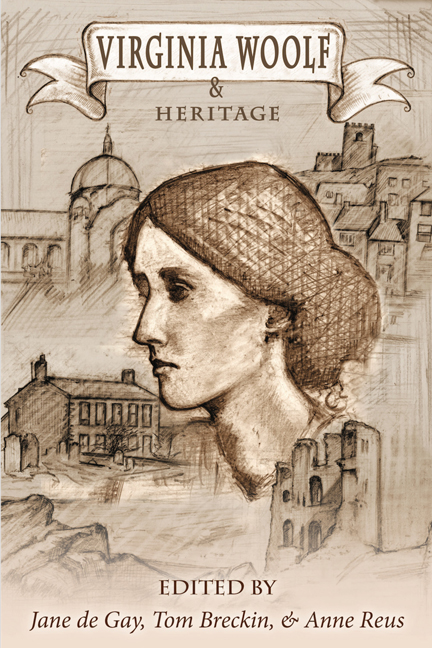Book contents
- Frontmatter
- Contents
- Introduction
- List of Abbreviations
- HERITAGE: A DEBATE
- HERITAGE, EDUCATION, AND MENTORING
- HERITAGE SPACES
- LITERARY AND CULTURAL HERITAGES
- QUEER PASTS
- MODERNISM AND HERITAGE
- Resetting the Type: An Exploration of the Historical Sense in Mrs. Dalloway
- Kenya Colony and the Kenya Novel: The East African Heritage of “A Very Fine Negress” in A Room of One's Own
- Leonard Woolf 's Fear and Politics: A Debate at the Zoo: Satirical Heritage as Apocalyptic Prophecy
- Virginia Woolf and the War on Books: Cultural Heritage and Dis-Heritage in the 1930s
- Gender Roles and the War Machine: An Undergraduate Roundtable on Virginia Woolf 's Legacies
- WRITING LIVES AND HISTORIES
- WOOLF'S LEGACIES
- FINALE
- Notes on Contributors
Virginia Woolf and the War on Books: Cultural Heritage and Dis-Heritage in the 1930s
from MODERNISM AND HERITAGE
- Frontmatter
- Contents
- Introduction
- List of Abbreviations
- HERITAGE: A DEBATE
- HERITAGE, EDUCATION, AND MENTORING
- HERITAGE SPACES
- LITERARY AND CULTURAL HERITAGES
- QUEER PASTS
- MODERNISM AND HERITAGE
- Resetting the Type: An Exploration of the Historical Sense in Mrs. Dalloway
- Kenya Colony and the Kenya Novel: The East African Heritage of “A Very Fine Negress” in A Room of One's Own
- Leonard Woolf 's Fear and Politics: A Debate at the Zoo: Satirical Heritage as Apocalyptic Prophecy
- Virginia Woolf and the War on Books: Cultural Heritage and Dis-Heritage in the 1930s
- Gender Roles and the War Machine: An Undergraduate Roundtable on Virginia Woolf 's Legacies
- WRITING LIVES AND HISTORIES
- WOOLF'S LEGACIES
- FINALE
- Notes on Contributors
Summary
In front of the library at Washington State University is Terry Allen's bronze sculpture, “Bookin’, “ a walking human form made of books. We may be what we read, as the sculptor suggests, but our books do not conveniently walk from one job, office, or home to another. We load them into heavy boxes and vow—uselessly—“No more books!” Our personal libraries can be burdens. Still, collected together, our books reflect intellectual growth and cultural heritage. How would we react if some extremist labeled us heretics, then confiscated or destroyed our writings, personal libraries, or the academic and public libraries we use?
In the 1930s, the Nazis launched a campaign of book burning that targeted socalled unGerman ideas, first in Germany, then in countries it occupied. Prior to Britain's declaration of war in 1939, Hogarth Press publications warned about intellectual intolerance on the continent. Today, with cultural devastation still rampant, scholars and historians are looking back at Nazi book burning. These interrelated contexts—Nazi cultural destruction, Hogarth Press responses, and scholarly retrospectives—are large topics in themselves. A brief look, however, helps to illuminate the last years of Virginia Woolf 's book-centered life. In a decade of book burning on the continent, and twenty years after a suffragette arson campaign in England, Woolf used fire to wage peace in Three Guineas.
“When they burn books, they will also, in the end, burn human beings.”
—Heinrich Heine, 1821 (qtd. Knuth, Burning 2)
“Only our books? Once they would have burned us with them”
—Sigmund Freud, 1933 (qtd. Polastron 182)
These comments were both historically apt and prophetic. Soon after Adolf Hitler became Chancellor in January 1933, the Third Reich banned all printed materials containing so-called “inaccurate information” (Polastron 179). Beginning on May 10th, in Berlin and over thirty other towns, university students and Hitler's brown shirts flung onto bonfires thousands of books. They did it with jubilant pageantry, sang Nazi anthems, and gave the Nazi salute. As a French journal reported, “with each new packet of books…, a voice declared the name of the…author and pronounced the sentence of execution” (Polastron 180). Because a major target in Berlin was the Magnus Hirschfield Institute for Sexual Science (Knuth, Burning 102), a good example is this announcement: “Against spiritual corruption and the…unhealthy complication of sexuality…, I commit to the flames the works of Sigmund Freud” (Polastron 180).
- Type
- Chapter
- Information
- Virginia Woolf and Heritage , pp. 176 - 182Publisher: Liverpool University PressPrint publication year: 2017



